
|
Sale 75
September Pre Long Beach
| Seated Liberty Half Dollars |
| |
| |
| Lot |
Photo |
Description |
Realized |
Lot 1482 |
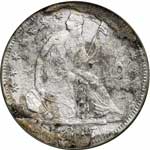 |
1847-O. Ex S.S. Central America Treasure. PCGS Certified with the Gold Sticker. Estimated Value $1,800 - 1,900
View details and enlarged photos
| Unsold |
Lot 1483 |
 |
1848. Ex S.S. Central America Treasure. PCGS Certified with the Gold Sticker. Estimated Value $1,800 - 1,900
View details and enlarged photos
| Unsold |
Lot 1484 |
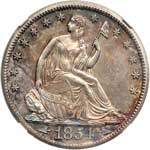 |
1854-O. Arrows. NGC graded SP-63. A needle sharp strike with semi reflective surfaces on both sides. The obverse displays light mottled russet and royal blue toning, while the reverse displays light golden hues within the recess. Pop 1; none finer at NGC.
This spectacular 1854-O Arrows half dollar traces to the famous Reed Hawn collection. To our knowledge this is the only Proof striking of the 1854-O half dollar. No others like it have surfaced in the years since, causing us to believe this is a unique piece where it is mentioned briefly on page 235 of Walter Breen�s 1977 Proof Encyclopedia: "Date slants up to r., 54 touch. Reed Hawn:183, $1,300, unverified." Examination of the photo of Reed's coin in the Stack's catalog when it resold in Heritage�s July 2008 ANA sale, positively identifies this as the coin from his historic offering of half dollars. The description in the Stack's catalog in 1973 was concise and explicit: "A magnificent Brilliant Proof, with full glittering surface even in the stripes of the shield on the reverse. There is no doubt that this is a specimen striking, not only because of its mirror surface, but also because of the perfection of strike. A lovely coin with pale russet and golden toning."
The surfaces display full, smooth mirror surface over both sides. Furthermore, the striking definition exhibits exceptional detail. As to the reason for such a coin to having been struck, Breen did not speculate. The true story behind this coin like so many before must be assumed to be lost forever. Yet, according to the Heritage description, the "attributes of the piece stand as testament that something special was done to create a specimen striking in New Orleans in 1854. This is the only coin even rumored to exist as a specimen or Proof striking of the 1854-O half dollar."
A landmark rarity for the Year 2013!
By 1850, the massive flows of gold from California had depressed the prices of that metal, and made silver more valuable by comparison. Hence, all silver coins disappeared from circulation as they were worth more than face value. Depositors gave little silver to the mints for coinage, and there were no denominations in circulation between the cent and gold dollar. Something had to be done, so in 1853 Congress reduced the amount of silver for minor denominations, in order to reflect the market value of silver as compared to gold. On the half dollar, the weight was reduced from 206.25 grains to 192 grains, and Mint Director George Eckert ordered quick changes to the dies so the entire design did not have to be changed. Arrows were added at the date, and on the reverse, rays were added surrounding the eagle. These design changes caused a problem, the dies cracked and broke to pieces much faster with the arrows and rays. In fact, die life fell to one-third normal, and dies had to be replaced rapidly. When Col. James Ross Snowden took as Mint Director in 1853, he immediately ordered the rays removed starting in 1854, both to extend die life and because so little of the heavier pre arrows coinage was in circulation by then. The arrows were later dropped starting in 1856. Estimated Value $30,000-UP
View details and enlarged photos
| Realized
$41,400 |
Lot 1485 |
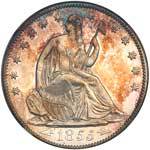 |
1855. Arrows. NGC graded Proof 66 Cameo. We note a minor planchet flaw on the reverse above "D". A mix of original colors on the obverse, with a bit less abundance on the reverse. The motifs are frosty while the fields are reflective; most importantly, the cameo they provide is noted on the NGC holder. Very few Proofs of this date exist. In addition to the perfect date Proofs minted in 1855, there are a few struck with an 1855/4 overdated die. On the present coin, the devices including date, stars, and legends, are strong and unmistakable, razor-sharpness noted everywhere. Fields are deep, reflective, and indeed, reflect perfectly the high grade that NGC has assigned to the coin A very rare and interesting With Arrows coin that will see a fair amount of bidding activity before it lends its beauty to an outstanding collection.
Why are there arrows beside the date on Half Dollars minted in 1853 to 1855? By 1850, the massive flows of gold from California had depressed the prices of that metal, and made silver more valuable by comparison in the better items-metallic system in use in the 19th century. The consequence was that most all silver coins disappeared from circulation as they were worth more than face value. Depositors gave little silver to the mints for coinage, and there were no denominations in circulation between the cent and gold dollar. Something had to be done. In 1853 Congress addressed the issue by reducing the amount of silver for minor denominations (but not the Silver Dollar), in order to reflect the market value of silver as compared to gold. On the half dollar, the weight was reduced from 206.25 grains to 192 grains, and Mint Director George Eckert ordered quick changes to the dies so the entire design did not have to be changed. Arrows were added at the date, and on the reverse, rays were added surrounding the eagle. These design changes caused a problem, the dies cracked and broke to pieces much faster with the arrows and rays. In fact, die life fell to one-third normal, and dies had to be replaced rapidly. When Col. James Ross Snowden took over as Mint Director in 1853, he immediately ordered the rays removed starting in 1854, both to extend die life and because so little of the heavier pre arrows coinage was in circulation by then. The arrows were later dropped starting in 1856. Only a few Proof specimens were struck, and their mintage was not recorded. Only estimates exist now as to how many Proofs are extant. Pop 1; none finer at NGC. Estimated Value $30,000-UP
View details and enlarged photos
| Realized
$63,250 |
Lot 1486 |
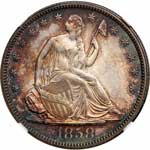 |
1858. NGC graded AU-58. Premium Quality. Nicely toned and well struck. Estimated Value $450 - 500
View details and enlarged photos
| Realized
$483 |
Lot 1487 |
 |
1860-O. WB-102. PCGS graded MS-66. Well struck and frosty with delicate golden and antique hues. A great deal of discussion also surrounds a coin's strike. This 1860-O has excellent detail with no sign of weakness to the key high points in the design; beautiful. The striking details are fully brought up on the head of Liberty and the eagle. A truly outstanding example of the second to last issue of half dollars made at the New Orleans Mint, a coin fit for a connoisseur's cabinet. Pop 6; none finer at PCGS. (PCGS # 6300)
Die note: A jagged die crack extends between the lower leaves to the border left of the H in HALF, and some die erosion is visible at the upper right quadrant of the shield, and into the right wing. This variety is named "Weird Vertical Stripes" in the Wiley-Bugert Seated Half Dollar reference. Estimated Value $8,000 - 9,000
View details and enlarged photos
Check results on similar lots
| Realized
$11,500 |
Lot 1488 |
|
1861-O 50¢ S.S. Republic Shipwreck Coins. A Lot of 10-Pieces, each NGC graded AU and Unc Shipwreck Effect. Some described as Confederate States Issue. Each housed in a special deluxe wooden box with descriptive booklet by Odyssey Marine Exploration with a COA. Lot of 10 coins. Estimated Value $2,000 - 2,500
The Arden Collection.
View details
| Realized
$3,220 |
Lot 1489 |
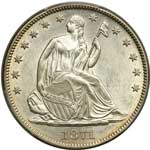 |
1871. PCGS graded MS-62. Bright, frosty, and untoned. Pop 12; 37 finer, 12 in 63, 18 in 64, 4 in 65, 3 in 66. (PCGS # 6330) Estimated Value $450 - 500
View details and enlarged photos
Check results on similar lots
| Realized
$776 |
Lot 1490 |
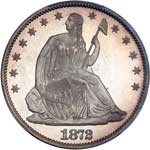 |
1872. PCGS graded Proof 66 Cameo. Only 950 minted. A lovely gem displaying a natural film of light cloudy grey toning. Mint luster like brilliant frosted glass gives this coin much of its life and pizzazz. Struck with scientific exactness throughout the stars, hair and shield along with Liberty�s drapery folds and sandal. On the reverse, similar exactness presents itself. The scroll with IN GOD WE TRUST, all neck, wing, and leg feathers, and a downright bold shield. Among the finest reported: Pop 2; none finer at PCGS (PCGS # 86430) Estimated Value $6,500 - 7,500
View details and enlarged photos
Check results on similar lots
| Realized
$8,338 |
Lot 1491 |
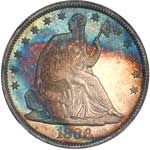 |
1886. NGC graded Proof 65. Nice blue and gold toning. Only 886 struck. A high degree of mirror reflection spins smoothly on the beautifully toned surfaces of this elusive Gem Proof Seated Half Dollar. The strike is crisp in most areas, as one would expect from a Proof, with full detail noted at the surrounding stars, Liberty, and eagle. Proofs were struck twice by the dies, and usually on the Mint�s special medal press, whereas circulation strike coins were run through the main steam (and later, electric motor operated) faster coining presses, and given only one strike by the dies. Hence the clearer, sharp details seen on the Proofs. A lovely example! Doubtless, it required many weeks or months of searching before the consignor located this splendid coin. We expect that bidders will recognize its superior condition and compete aggressively. Pop 23; 26 finer. Estimated Value $3,000 - 3,100
View details and enlarged photos
| Unsold |
|
|